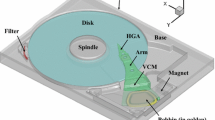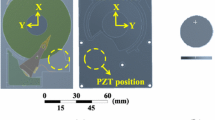Abstract
Since its introduction, the mass-reducing hole in the middle of an actuator arm has been investigated as a source of turbulent flow in the space between a pair of co-rotating disks in an air-filled Hard Disk Drive (HDD). The present study investigates the effect of the mass-reducing hole by performing Particle Image Velocimetry (PIV) and numerical calculation in both air and helium. Helium was selected as an alternative medium due to its high kinematic viscosity which is expected to stabilize the turbulent flow around the actuator arm. A double-scale experimental apparatus was built to simulate a commercial drive. The same model was simulated numerically. The investigations were performed for two different positions of the actuator arm and two angular speeds of the disk (1,000 and 3,000 rpm; corresponding to 4,000 and 12,000 rpm in a 3.5-inch commercial drive). Experimental data was collected at the inter-disk mid-plane and ensemble-averaged to compute the turbulence intensity. The results show that, as expected, the helium flow induces lower turbulence intensity than the air flow at low speeds of rotation. In particular, the helium flow stabilizes the turbulent flow around the Slider Suspension Unit (SSU) more effectively than the air flow. However, at high speeds of rotation, the helium flow generates a higher level of turbulence intensity immediately behind the mass-reducing hole than the air flow. The physical mechanism of the switch is explained.


















Similar content being viewed by others
References
Abrahamson SD, Koga DJ, Eaton JK (1988) The flow between shrouded co-rotating disks. Phys Fluids 11(2):241–251
Abrahamson SD, Koga DJ, Eaton JK (1991) Flow structure in head-disk assemblies and implications for design. Adv Info Storage Sys 1:111–132
Barbier C, Humphrey JAC, Maslen E (2006) Experimental study of the flow in a simulated Hard Disk Drive. J Fluid Eng 128:1–11
Davidson PA (2004) Turbulence. An introduction for scientists and engineers, Oxford
Herrero J, Giralt F, Humphrey JAC (1999) Influence of the geometry on the structure of the flow between a pair of co-rotating disks. Phys Fluid 11(1):88–96
Hirono Y, Arisaka T, Nishijima N, Shimizu T, Nakamura S, Masuda H (2004) Flow-induced vibration reduction in HDD by using a spoiler. IEEE Trans Magn 40(4):3168–3170
Iglesias I, Humphrey JAC (1998) Two and Three-Dimensional laminar flows between disks co-rotating in a fixed cylindrical enclosure. Int J Numer Methods Fluid 26:581–603
Kaneko S, Nishihara T, Watanabe T (2007) Aerodynamic characteristics of carriage arm equipped on hard magnetic disks. Microsyst Technol 13:1297–1306
Kazemi K (2008) Analysis of the slider off-track vibration caused by the aerodynamic loads associated with different components of a head stack assembly in a disk drive. IEEE Trans Magn 44(5):633–639
Kazemi K (2009) Investigation of fluid structure interaction of a head stack assembly in a hard disk drive. IEEE Trans Magn 45(12):5344–5351
Keiji A, Suwa M, Shimizu K, Watanabe T (2007) A study on positioning error caused by flow induced vibration using helium-filled disk drives. IEEE Trans Magn 43(9):3750–3755
Kil SW, Humphrey JAC, Haj-Hariri H (2012a) Experimental study of the flow-structure interactions in an air- or helium-filled hard disk drive model. Microsyst Technol 18:43–56
Kil SW, Humphrey JAC, Haj-Hariri H (2012b) Numerical study of the flow-structure interactions in air- or helium-filled simulated hard disk drives. Microsyst Technol 18:57–75
Kubotera H, Tsuda N, Tatewaki M, Maruyama T (2002) Aerodynamic vibration mechanism of HDD arms predicted by unsteady numerical simulations. IEEE Trans Magn 38(5):2203–2207
Lennemann E (1974) Aerodynamics aspect of disk files. IBM J Res Dev 18:480–488
Schuler CA, Usry B, Humphrey JAC, Greif R (1990) On the flow in the unobstructed space between shrouded corotating disks. Phys Fluids A 2(10):1760–1770
Soong C-Y, Wu C–C, Liu T-P, Liu T-P (2003) Flow structure between two co-axial rotating independently. Exp Thermal Fluid Sci 27:295–311
Tzeng H-M, Humphrey JAC (1991) Co-rotating disk flow in an axi-symmetric enclosure with and without bluffing body. Int J Heat Fluid Flow 12(3):194–201
Tatewaki M, Tsuda N, Maruyama T (2001) An analysis of disk flutter in hard disk drives in aerodynamic simulations. IEEE Trans Magn 37(2):842–846
Usry WR, Humphrey JAC, Greif R (1993) Unsteady flow in the obstructed space between disks corotating in a cylindrical enclosure. J Fluid Eng 115:620–626
Webster DR, Humphrey JAC, Schuler CA (1995) Unsteady laminar flow between a pair of disks corotating in a fixed cylindrical enclosure. Phys Fluids 7(6):1225–1240
Yip TH, Tan CK, Kuan YK (2006) Behavior of spiral flow structures along the trailing edges of e-block arms under increasing airflow velocities. IEEE Trans Magn 42(10):2591–2593
Zhang QD, Tan CS, Sundaravadivelu K, Suriadi MA, Chin GL, Yip TH, Ong EH, Liu NY (2010) Mitigation of flow induced vibration of head gimbal assembly. Microsyst Technol 16:213–219
Acknowledgments
The author acknowledges financial support by INSIC (Information Storage Industry Consortium) for his master’s studies. SK and HH-H express their gratitude to Joseph A.C. Humphrey for his conception of the ideas underpinning this work. Professor Humphrey passed away prior to completion of this work.
Conflict of interest
The authors declare that they have no conflict of interest.
Author information
Authors and Affiliations
Corresponding author
Rights and permissions
About this article
Cite this article
Kil, S.W., Humphrey, J.A.C. & Haj-Hariri, H. Turbulence intensity inversion induced by the mass-reducing hole in an air or helium filled hard disk drive. Microsyst Technol 19, 31–42 (2013). https://doi.org/10.1007/s00542-012-1589-7
Received:
Accepted:
Published:
Issue Date:
DOI: https://doi.org/10.1007/s00542-012-1589-7




